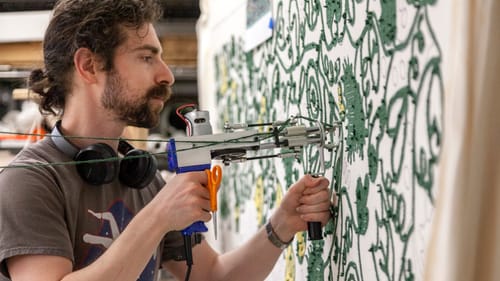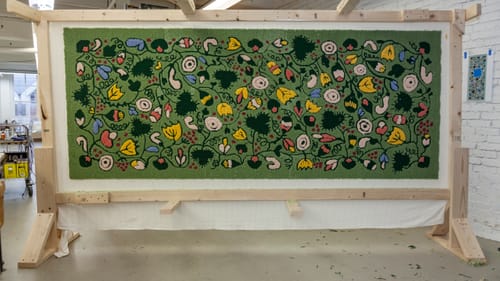Stay in the Loop
BSR publishes on a weekly schedule, with an email newsletter every Wednesday and Thursday morning. There’s no paywall, and subscribing is always free.
A safe space for uppity women
Fabric Workshop and Museum presents Jessica Campbell: Heterodoxy

The last meeting of the Heterodites was 83 years ago. No minutes were kept. No attendance taken. Little was known of feminist debate society Heterodoxy when it existed, much less now. Members kept things confidential. So why is multimedia artist and author Jessica Campbell so interested? Find out at Heterodoxy, her fanciful homage at Fabric Workshop and Museum (FWM).
Heterodoxy (meaning deviation from accepted doctrine) was active from 1912 to 1940 in New York City. Membership consisted of something over 100 women from different backgrounds, views, and professions.
They were independent thinkers hungry for intelligent discussion on issues affecting women: voting rights, economic equality, child care, and reproductive freedom. These issues had mostly been decided by society on women’s behalf, largely without their input. Women who thought for themselves were frowned upon and, if too outspoken, ostracized. Since club members had no intention of begging to differ, they met in secret.
Heterodox methods
Campbell makes sense of the world through art built around personal anecdotes, humor, graphic novels, and comics. She usually works alone but spent 2023 in residence at FWM. Collaborating, she said recently, was new: “Having a group of talented, thoughtful artists [to work with] changed the trajectory of the work, and they have technical expertise I don’t have. … That was a remarkable thing.”
As it turned out, Heterodoxy would require all of the artists to expand their skill sets as they built unique display tables, designed complex lighting, and made rugs by hand—many, many rugs.
Researching the group was difficult. News items were sparse, and the women themselves had written little or nothing. Sometimes, all Campbell found was a member’s name. Instead of surrendering to the factual deficit, she made it a springboard for an imaginative pseudohistory of Heterodoxy and, with FWM, fabricated a meeting room/archive in which to present it.
Whether real or invented, details make Heterodoxy more engaging, but Campbell wants to do more. She wants the blend of fact and fiction to make viewers skeptical (in a healthy way) and to “reflect on what they see in museums.” She wants to convey that all exhibitions are, to some extent, creations shaped by curatorial decisions.
A seat at Polly’s
Step into the softly lit room representing Polly’s, a Greenwich Village restaurant where early meetings were held. Have a seat at one of three long tables and inspect items in embedded illuminated vitrines.
Read from a rare copy of Portrait of Mabel Dodge at the Villa Curonia (1912), a limited-edition book by Gertrude Stein. Both Stein and her subject were Heterodoxy members, and she composed the piece while visiting Dodge in Italy. Stein said it was an “experimental word-picture,” her attempt to do linguistically what Picasso did visually, as in: “There is that particular half of directing that there is that particular whole direction that is not all the measure of any combination. Gliding is not heavily moving. Looking is not vanishing. Laughing is not evaporating. There can be the climax.” Sounds just like a Picasso, and just like a Stein, too.
Another vitrine displays a poster for a 1914 mass gathering of feminists and the feminist-curious hosted by Heterodoxy founder Marie Jenney Howe. The two-day event presented talks on the rights inherent in feminism, such as a mother’s right to pursue a profession, of married women to retain their own names, of all women to ignore fashion, organize, and think for themselves. It featured a speech by club member Frances Perkins, who in 1933 would become Franklin Roosevelt’s secretary of labor, the first woman to serve in a presidential cabinet.
There are period items, a flowered handkerchief, a wood carving, a pencil box, and a tool from Polly’s to trim candlewicks. The wooden man reportedly belonged to Grace Nail Johnson, prominent in civil-rights work and the Harlem Renaissance, Heterodoxy’s only known Black member. The pencil box supposedly belonged to female political cartoonist and member Lou Rogers.
Uproarious upholstery
Rogers (1879-1952) took on controversies like birth control and women’s suffrage, and her work is said to have inspired the character Wonder Woman. A Rogers cartoon on view depicts a woman leashed to a policeman representing “The State.” She is crushed beneath an enormous scroll labeled “Laws Controlling Women’s Bodies.”
If Rogers illustrated the philosophy explored in Heterodoxy, Amy Mali Hicks (1967-1954) provided the decorative theme. Designs from Hicks’s 1914 book The Craft of Hand-Made Rugs inspired the intricate vine and flower motif on 16 wall-hung carpets that wrap the room.
Making the four-by-eight-foot rugs was an all-hands effort that required training by Tuft the World and 500 pounds of yarn, which artists injected into webbing with tufting guns.
“We all learned to tuft,” recalled FWM chief curator DJ Hellerman. “We tufted for months! It was an undertaking.” In addition to the studio team, Hellerman acknowledged the contributions of lead artist Allen West, who collaborated with Campbell and designed the project’s custom lighting, which ebbs and flows every few minutes. Heterodoxy’s originating curator was Karen Patterson, former FWM director of exhibitions.
Several carpet panels have windows revealing Rogers’s cartoons and Campbell’s playful member portraits. The artist noted that the comic-style images are her answer to what she called the room’s “stuffiness” and “suffocating” feel.
A sharpened parallel
While the era was undoubtedly restrictive, the exhibition doesn’t feel claustrophobic in the least. True, it is well-upholstered, and it can be dim, but this serves to sharpen the parallel between two eras. As ambient light subsides on the objects and images of the past, windows and vitrines become looking glasses in this similarly constrictive moment. Suddenly, visitors are gazing into their own faces, and it seems the women are observing them and asking, “What are you going to do?”
Campbell intends Heterodoxy to be more than a space for reflection: “I want this to function as an actual meeting space.” FWM is making plans for a series of talks, and the space may be available to groups to let unorthodox minds roam unfettered.
What, When, Where
Jessica Campbell: Heterodoxy. Through March 24, 2024, at Fabric Workshop and Museum, 1214 Arch Street, Philadelphia. (215) 561-8888 or fabricworkshopandmuseum.org.
Accessibility
FWM’s main entrance is accessible for standard wheelchairs. All floors are accessible by elevator and have accessible single-user restrooms. For more information, call (215) 561-8888, ext. 233.
Sign up for our newsletter
All of the week's new articles, all in one place. Sign up for the free weekly BSR newsletters, and don't miss a conversation.


